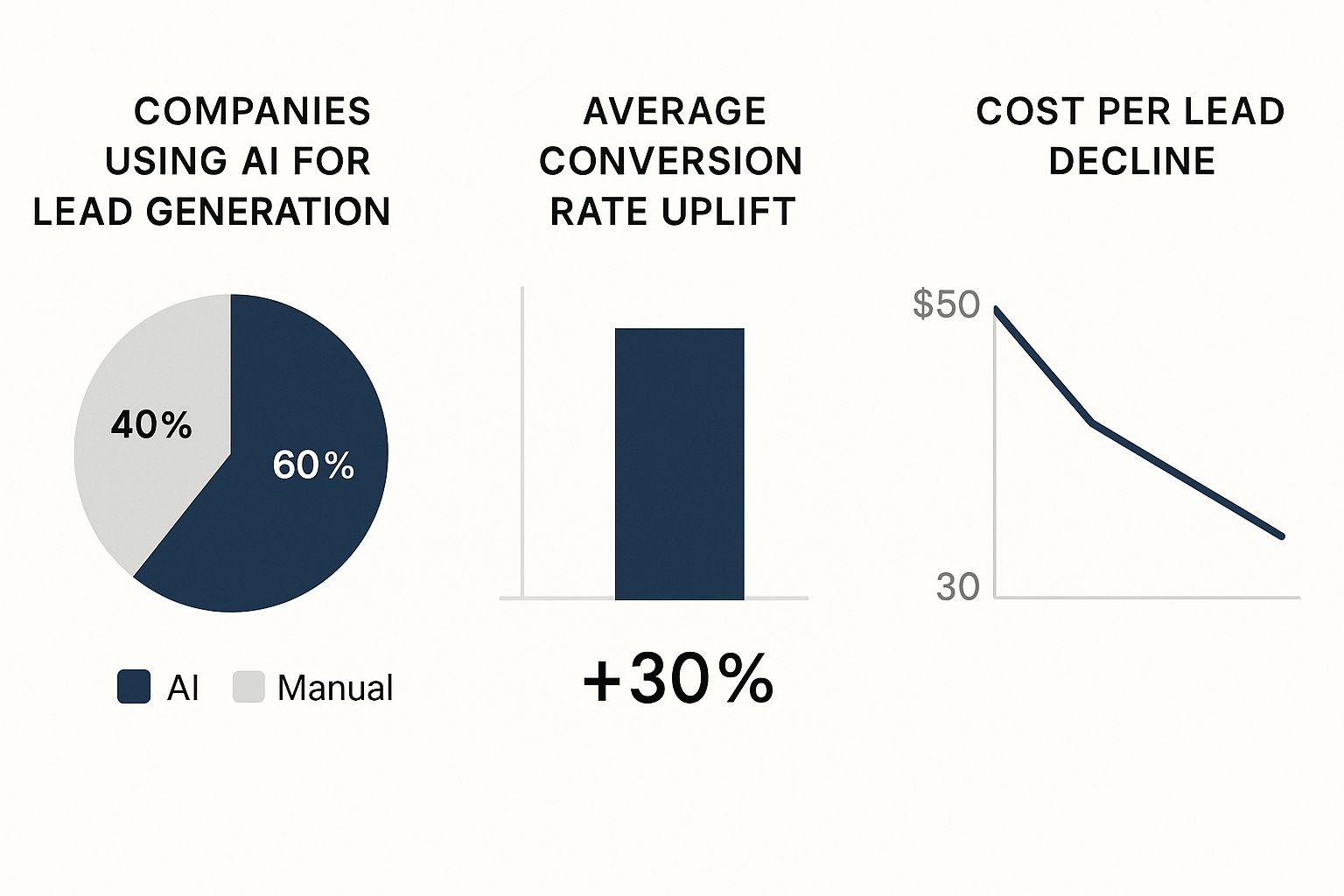AI Lead Generation That Actually Works: Real Strategies
Why AI Lead Generation Changes Everything

Why AI Lead Generation Changes Everything
The infographic above really brings home the impact of AI on lead generation. Look at the numbers: more companies are using AI, seeing a 30% boost in conversions, and dropping their cost per lead from $50 to $35. This isn't just a fleeting trend; it’s a real shift in how we find and nurture potential customers.
The beauty of AI lead generation isn’t about replacing human intuition – it’s about supercharging it. Think of it as having a tireless research assistant sifting through mountains of data to pinpoint your hottest leads. That frees up your team to focus on what they excel at: building real connections and closing deals. I’ve seen this firsthand in Germany, where businesses are increasingly using AI to connect with customers on a deeper level. This reflects Germany’s broader adoption of AI, with the market projected to hit a whopping US$40.46 billion by 2031, growing at a 26.33% annual rate. Want to dive deeper into the German AI market? Check out these insights: here.
How AI Transforms the Lead Generation Landscape
AI lead generation tools use machine learning to predict customer behavior with impressive accuracy. Imagine targeting your marketing efforts only towards prospects showing active buying signals, instead of casting a wide net and hoping for the best. This precision is a game-changer, especially in competitive industries.
Natural language processing (NLP) allows for personalized communication that feels genuine and human. Think about those perfectly timed emails that speak directly to a prospect’s needs and pain points, making them feel understood. This isn’t about spamming generic messages; it's about using AI to tailor your communication for maximum impact.
To help you understand the different AI technologies available, I've put together a comparison table. It outlines their applications in lead generation, along with effectiveness ratings and implementation difficulty.
AI Lead Generation Technologies Comparison
Technology | Lead Gen Application | Effectiveness | Implementation Difficulty | Best Use Case |
Machine Learning | Predictive Lead Scoring | High | Medium | Identifying high-potential leads |
Natural Language Processing (NLP) | Personalized Email Marketing | High | Medium | Tailoring communication to individual prospects |
Deep Learning | Lead Segmentation | Medium | High | Grouping leads based on shared characteristics |
Computer Vision | Social Media Lead Identification | Medium | Medium | Finding leads based on visual content |
This table provides a snapshot of how different AI technologies can be applied to lead generation. While Machine Learning and NLP are highly effective and moderately difficult to implement, Deep Learning and Computer Vision offer specialized applications that might require more technical expertise.
Addressing the Fear of Automation
Many people worry that AI will replace sales jobs. In my experience, however, the best approaches actually enhance human relationships. AI takes over the tedious work of data analysis and lead qualification, letting sales teams concentrate on building rapport and providing personalized guidance. It’s a powerful combination where AI and human intelligence work together to achieve better outcomes.
Setting Up Your AI Foundation The Right Way
Let's be honest, a lot of companies dive headfirst into the latest AI tools without a solid plan. I've seen it firsthand: exciting AI projects fall flat because teams skipped the essentials. The companies that really nail it? They prioritize their data first.
Think of it like building a house. You wouldn't put a fancy roof on a shaky foundation. AI is the same way – it needs clean, organized data to work its magic. Your CRM might be a goldmine of customer info, but if it's a mess, it's quietly sabotaging your AI efforts.
Data Cleansing That Actually Matters
So, how do you get your data AI-ready? Forget the fancy jargon, it's all about practical steps. Deduplicating entries might seem basic, but it’s critical. Imagine your AI trying to learn from duplicate customer profiles – it's like trying to read a book full of typos. Standardizing data formats is just as important. "01.02.2024" and "2/1/2024" might mean the same thing to you, but they’ll confuse your AI.
Building Buy-In and Feedback Loops
Tech is only half the battle. People can be hesitant about AI, worried about their jobs or losing control. Addressing these concerns head-on is key. Show them how AI will help them, not replace them. This builds trust and encourages adoption.
Feedback loops are crucial too. Your sales team has a wealth of knowledge about customer interactions that AI might miss. Their insights can refine the system, making it smarter and more effective over time. Speaking of getting smarter, you might find this helpful: Check out our guide on Generative Engine Optimization Basics.
The Timeline Reality Check
Let's talk timelines. Rushing the foundation is a recipe for disaster. Building a robust data infrastructure and integrating AI takes time. Look at Germany, for example. The AI scene is booming, with the average valuation of AI companies hitting €92 million by 2025. This shows the level of investment needed for successful AI integration. Learn more here. Setting realistic expectations upfront avoids frustration and allows for thoughtful development. Remember, AI is a marathon, not a sprint. A well-planned approach, centered on data quality and teamwork, sets you up for long-term success with AI lead generation.

Tools Like SEOpace Help You to Measure Your Ranking KPIs
AI Tools That Generate Leads Worth Pursuing
Let's cut through the hype and talk about AI tools that actually deliver. After trying out tons of platforms and chatting with successful teams in Germany, I've seen what works. Surprisingly, the best AI lead generation isn't about splurging on the most expensive software. It's about combining the right tools that work well together.
Take chatbots, for example. The truly effective ones are so much more than simple FAQ responders. They're like having a 24/7 team member qualifying leads and gathering key info before your sales team even gets involved. I've seen this do wonders for B2B companies in Germany, especially those dealing with a high volume of incoming inquiries.
Then there's predictive analytics software. This is where things get really exciting. These tools analyze past data to pinpoint high-value prospects before they even know they're ready to buy. It's like having a glimpse into the future, powered by smart algorithms. The goal is anticipating needs and offering solutions at the perfect moment.
Personalizing content is another essential piece of the puzzle. Generic content just doesn't resonate anymore. AI-powered engines analyze customer behavior to tailor truly relevant experiences. Think dynamic website content that shifts based on individual preferences, or email sequences that adjust to engagement patterns. This isn't about being invasive; it's about delivering the right info at the right time, creating a smooth and engaging customer journey.
The Wikipedia screenshot above visually represents the complex web of AI, highlighting its different areas and applications. It shows how wide-ranging AI is and its potential impact on various industries, including marketing and sales. This complexity underscores the importance of choosing the right AI tool for your specific lead generation needs and integrating it smoothly into your existing processes.
Furthermore, some emerging AI tools are analyzing customer behavior patterns that most people haven't even considered yet. These tools are what give you a real competitive edge. The German AI market is exploding right now. From 2025 to 2030, the German enterprise generative AI market is projected to grow at a CAGR of 38.8%. This growth shows just how important AI is becoming for businesses, especially in manufacturing and automotive, where generative AI can personalize marketing and automate lead nurturing. Discover more insights on the German Enterprise Generative AI Market.
You might also find this interesting: AI vs. Google
Here's the bottom line: successful AI lead generation isn't about buying every tool available. It's about integrating them seamlessly with your existing CRM and marketing automation platforms. No one wants to rebuild their entire tech stack. Choose tools that work with your current systems, offering smooth data flow and minimal disruption. This lets you concentrate on what really matters: turning leads into loyal customers.
Personalization That Feels Human, Not Creepy
Generic outreach is a relic of the past. But let's be honest, poorly executed personalization is even worse – it can come across as insincere and even a bit creepy. The real magic of AI lead generation lies in that sweet spot where helpful meets relevant. I've seen B2B companies, especially in Germany, absolutely nail this, and the secret ingredient is always that human touch.
The Power of Subtle Personalization
The best AI personalization doesn't scream "robot." It whispers, "I get you." Think about it: a thoughtful question about a recent industry event you attended, or a mention of a shared connection on LinkedIn. These small details show you've actually done your research. AI can analyze data points you wouldn't even dream of – from browsing history and social media activity to the time of day a prospect is most engaged. This gives you the power to personalize your approach in a way that feels natural, not forced.
For example, I once worked with a SaaS company that was using AI to analyze prospect engagement with their blog. They uncovered a goldmine of an insight: readers who spent more than two minutes on articles about a specific feature were 60% more likely to convert. Armed with this knowledge, they set up personalized email sequences offering a free trial of that very feature. The result? A significant boost in conversions.
Dynamic Content and Engagement
This personalized approach goes way beyond email. Imagine a prospect landing on your website and being greeted with content tailored specifically to their industry’s biggest challenges. Dynamic website content that adapts in real-time based on visitor behavior can create this powerful sense of relevance and encourage deeper engagement.
Another fantastic example? Email sequences that adjust based on how a prospect interacts with them. Let's say a prospect opens an email but doesn’t click any links. The next email in the sequence can then offer a different angle, a new value proposition, or perhaps a more direct call to action. This kind of iterative, responsive approach helps you fine-tune your message based on individual preferences.
Building Trust Through Ethical Practices
Transparency is paramount. Be upfront with your prospects about how you're using their data. This not only builds trust, but it also demonstrates respect. Steer clear of anything that feels too intrusive, like referencing overly personal information. Remember, the goal is to be helpful, not creepy. I've seen companies successfully implement "preference centers," giving prospects the reins to choose what kind of communication they receive and how their data is shared. This empowers prospects and fosters a positive, transparent relationship.
And of course, testing is key. A/B test different personalization strategies to see what resonates with your DE audience. What feels personalized to one person might feel invasive to another. By continually testing and refining your approach, you’ll hit that perfect balance that maximizes conversions without alienating your audience. Getting this right truly unlocks the power of AI lead generation.
Let's take a look at how this plays out in real-world results. The table below showcases the potential ROI of using AI for personalized campaigns:
AI Personalization Metrics and ROI
Key performance indicators for AI-driven personalization campaigns, showing typical improvement ranges and measurement timeframes
Metric | Traditional Approach | AI-Enhanced | Improvement Range | Measurement Period |
Conversion Rate | 2-5% | 5-15% | 3-10% | 3-6 Months |
Click-Through Rate | 1-3% | 3-8% | 2-5% | 1-3 Months |
Customer Lifetime Value | $500-$1000 | $750-$1500 | 25-50% | 12 Months |
Engagement Rate | 0.5-1% | 1-3% | 0.5-2% | 3-6 Months |
As you can see, leveraging AI for personalization can significantly improve key metrics across the board. While results can vary depending on industry and implementation, the potential for increased engagement, conversions, and ultimately, ROI, is substantial.
Scaling Without Losing Your Soul
For everyone new to this, I highly recommend watching Shep Hyken's Masterclass on the personalization of Marketing: https://www.youtube.com/watch?v=E9KvpbYHldU After you've seen firsthand how effective AI lead generation can be, the next big challenge is scaling it. This is where things get really interesting. I've watched businesses in Germany go from hundreds to thousands of qualified leads per month, all while keeping their conversion rates stable. The patterns I've observed are fascinating. The secret isn't necessarily more technology; it's about maintaining that crucial human element as your volume grows.
Take a look at Salesforce Marketing Cloud:
This screenshot shows features like personalized email journeys and data-driven insights. These kinds of tools become absolutely essential for managing larger audiences without sacrificing those individual experiences. Think about it: the more leads you have, the more important it is to keep your messaging targeted. Generic blasts just won't cut it if you want to keep engagement and conversion rates high.
Automation Strategies That Preserve the Human Touch
Successfully scaling AI lead generation means striking a balance between automation and personalization. It's like baking a cake: sure, you can use a mixer for the tough parts, but you still need a human touch for the frosting. For instance, automated email sequences can handle the initial outreach and follow-ups, freeing up your team to concentrate on building real relationships with highly qualified prospects.
Structuring Your Team for AI-Driven Growth
As your operation scales, your team's roles will naturally shift. Data analysts become incredibly important for making sure your data is clean and uncovering actionable insights. Sales roles evolve towards more consultative selling, focusing on building relationships and closing those complex deals. I've even seen companies in Germany create entirely new positions: dedicated AI specialists who focus on optimizing algorithms and creating truly personalized customer experiences.
Avoiding the Pitfalls of Rapid Scaling
Scaling too quickly can actually hurt your conversion rates. One common trap is becoming overly reliant on automation, which leads to impersonal interactions. Another is neglecting data quality as the volume increases. Keep an eye out for these warning signs: declining engagement, lower conversion rates, and negative customer feedback. These are all indicators that your growth might be coming at the expense of quality.
Maintaining Profitability at Scale
Efficient scaling requires a sharp focus on profitability. Automating repetitive tasks helps cut operational costs. Focusing your energy on high-value leads maximizes your return on investment. Plus, AI-powered analytics offer invaluable insight into how your campaigns are performing, allowing for continuous optimization and further cost reduction. Remember, growth should help your bottom line, not hurt it. By paying attention to these elements, you can effectively scale your AI lead generation efforts while keeping a human-centric approach. This way, you can nurture stronger customer relationships and achieve sustainable, profitable growth.
Measuring What Actually Matters

Seamless Technology Helps You Measuring What Really Matters
AI lead generation is a powerful tool, but it's not just about bringing in more leads. It's about attracting the right ones. I've seen firsthand how companies can get caught up chasing vanity metrics like click-through rates, losing sight of the ultimate goal: converting leads into loyal customers. From my experience, the metrics that truly indicate business growth are often the ones you might not expect.
Lead Quality Over Quantity
Let's be honest: 1000 disengaged leads aren't nearly as valuable as 100 highly interested prospects. That's why lead quality scores are so vital. A solid scoring system digs deeper than surface-level demographics and analyzes actual behavior patterns.
For example, think about a prospect who downloads multiple resources, regularly visits your pricing page, and even attends your webinars. These are strong buying signals!
This kind of detailed tracking allows you to concentrate on the leads with the highest conversion potential, maximizing your ROI. This is particularly important in the DE region, where GDPR compliance makes responsible data handling a must. Luckily, AI tools can help analyze this data ethically while still providing valuable insights.
Lifetime Value and AI-Driven Nurturing
Another often-overlooked metric is customer lifetime value (CLTV). AI-driven nurturing can have a major impact here. Personalized email sequences, targeted content recommendations, and even AI-powered chatbots can keep prospects engaged throughout the entire sales funnel. This boosts conversions and encourages repeat business.
Imagine a prospect abandons their shopping cart on your site. An AI chatbot can proactively reach out, offer assistance, and potentially save the sale! AI can also help predict which customers are likely to churn, allowing you to implement proactive retention strategies. This long-term focus aligns perfectly with the German emphasis on building lasting customer relationships.
Attribution Models for AI Initiatives
To really understand the impact of your AI efforts, accurate attribution modeling is key. Traditional models often miss the nuances of AI-driven campaigns. For instance, if a prospect chats with your AI chatbot before converting through a paid ad, how do you assign credit?
Robust tracking systems can help you unravel these complex interactions and get a clear picture of your AI ROI. A/B testing is essential, but testing AI systems requires a different approach. You might find this interesting: AI's Impact on SEO. Instead of just comparing two landing pages, you could test different algorithms or personalization strategies within your AI tools.
When reporting to executives, focus on the metrics leadership cares about – revenue growth, customer acquisition cost, and CLTV. Early warning signs, like a dip in lead quality or engagement, can alert you to needed adjustments in your AI systems before they affect your bottom line. By focusing on the right metrics and using sophisticated tracking, your AI lead generation efforts can drive real, sustainable business growth.
Your AI Lead Generation Game Plan
Alright, let's get down to brass tacks. We've covered a lot of ground, so now it's time to build a practical, actionable plan. This isn't some theoretical framework; this is built from what's actually worked for businesses here in Germany, across different industries and sizes.
Critical Early Decisions
Before diving into the tech, you have to figure out what problems you’re trying to solve with AI. Are you swamped with low-quality leads? Is personalizing your outreach feeling impossible? Or are you trying to scale your lead generation without losing that human touch? Knowing your destination is key – just like planning a road trip, you wouldn’t just start driving aimlessly.
And of course, budget matters. AI lead generation isn’t free. I've seen teams get starry-eyed over new tools, only to be blindsided by implementation, training, and maintenance costs. Setting realistic expectations for time and resources from the outset is essential.
Realistic Timelines and Budget
Let’s be real, seeing significant results with AI takes time. There are no overnight miracles here. Think of it as a long-term investment. Building a solid data infrastructure, training your team, and fine-tuning your AI can take months. Patience is a virtue – celebrate the small wins along the way!
When you're budgeting, don’t just look at the software price tag. Think about the hidden costs: training, data cleanup, and ongoing optimization. Factor these in to avoid any budget surprises down the road.
Warning Signs and Success Indicators
During implementation, keep an eye out for red flags. If you see declining lead quality, lower engagement, or negative customer feedback, something’s off. Don't ignore these warnings – they're your early warning system. Address them quickly before they hit your bottom line.
So what does success look like? Increased conversion rates, better lead quality scores, and a higher customer lifetime value are all good signs. Track these metrics closely to measure the true impact of your AI. Regularly review your progress and tweak your strategy as needed.
Vendor Evaluation and Team Preparation
Choosing the right vendor is crucial. Don't just buy into the marketing hype. Look for platforms that fit seamlessly with your existing systems and offer solid customer support. Your vendor should be a partner, not just a software provider.
Just as important is preparing your team. Address any anxieties about AI replacing jobs head-on. Emphasize how AI will empower them, not replace them. Provide comprehensive training and ongoing support to ensure a smooth transition.
Measuring Progress and Staying Aligned
Use templates and dashboards to track progress and keep everyone on the same page. Regularly share updates with your team and leadership to demonstrate the value of your AI investment. Openly celebrate successes and address challenges. This builds a culture of continuous improvement.
By focusing on these key elements, you’re building a solid base for your AI lead generation. This proactive approach sets you up for sustainable success, attracting and converting high-quality leads in the DE region and beyond.
Ready to transform your lead generation? Explore SEOpace and see how we can help you get leads from ChatGPT: https://seopace.ai

Peter Frank
GEO Strategist